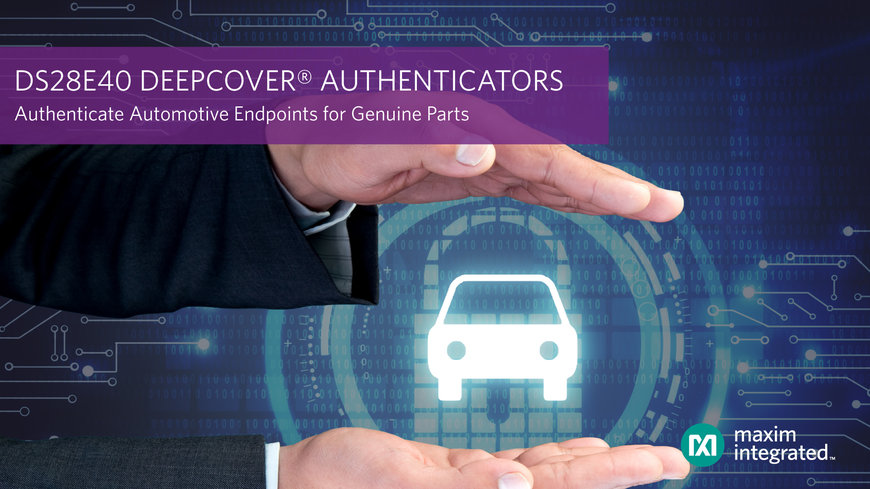Maxim Integrated’s Automotive-Grade Secure Authenticator for Genuine Parts Enhances Vehicle Safety and Security
DS28E40 is a parasitically-powered AEC-Q100 Grade 1 secure authenticator which enables the verification of genuine components in ADAS, EV batteries and other electronic systems.

In critical systems, genuine components are the safest and most reliable. Designers can now enhance safety, security and data integrity for connected vehicle systems while also reducing both complexity and code development time by authenticating genuine components with the DS28E40 DeepCover® automotive secure authenticator from Maxim Integrated Products, Inc. (NASDAQ: MXIM). As the newest addition to Maxim Integrated’s line of AEC-Q100 Grade 1 solutions for automotive systems, the DS28E40 is a parasitically-powered authenticator utilizing its 1-Wire interface for simple connectivity. This authenticator IC reduces the software vulnerability to ensure only genuine components are used for many electronic systems, such as advanced driver assistance systems (ADAS) and electric vehicle batteries.
As cars become more sophisticated with the features they offer, safety and security risks grow as well. Automotive manufacturers use authentication in two ways: to ensure only OEM-certified components are safely connected to vehicle systems and to reduce the growing threat of malware attacks. However, most full-blown secure microcontrollers have a relatively big footprint and require software development teams to create, rigorously test and debug their code. Here are the problems with current microcontroller-based solutions: The bigger the code base is, the higher the risk of bugs or malware adversely affecting performance. Plus, I²C and SPI interface automotive security solutions available on the market may require many interface pins—as many as five or six, including dedicated power and reset lines. More pins can lead to higher costs and more reliability issues.
The DS28E40 DeepCover authenticator is a fixed-function, 1-Wire solution that meets the AEC-Q100 standard Grade 1 performance standards and replaces microcontroller-based approaches. The fixed-function device gives OEMs a targeted algorithm and command toolset to meet their specific security needs, while reducing both system design complexity and associated code development efforts. Its public/private key asymmetric ECDSA (ECC-P256 curve) and other key authentication algorithms are built into the IC, allowing OEMs to skip development of proprietary device-level code. This and other algorithms in the authenticator IC provide the strongest defense against unauthorized components that could compromise performance, safety and data integrity.
The 1-Wire interface combines power and communication on a single pin and thus requires only two interconnects including the ground pin. Fewer interconnect pins reduce cost and further improves reliability by enabling smaller cable harnesses to connect an ECU to a remote endpoint. The DS28E40 comes in a compact, 4mm-x-3mm TDFN package and operates over the -40-degree to +125-degree Celsius temperature range.
Key Advantages
- Robust Security: Built-in symmetric key secure hash algorithm (SHA-256) support; secure storage of ECDSA and SHA-256 keys; one-time programmable nonvolatile memory for storage of digital certificates and manufacturing data; hardware-based security stronger than software approach
- Higher Reliability: Dedicated function reduces code size; 1-Wire interface reduces interface pins from 6 to 2
- Simple to Integrate: Authentication algorithms built into the IC eliminate device-level development code efforts; 1-wire interface and low software overhead on host side simplify design integration and does not require external power
Commentary
“The parasitically powered 1-Wire authenticator really opens up automotive endpoints that can be secured and properly authenticated by adding just one chip,” said Michael Haight, director, Embedded Security at Maxim Integrated. “With the ground plus single contact for power and communication, even a passive automotive component that doesn’t otherwise have electronics could be connected to an engine control unit (ECU) and authenticated.”
www.maximintegrated.com

